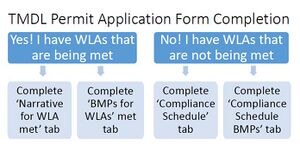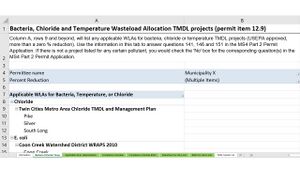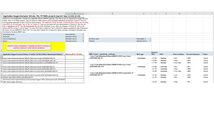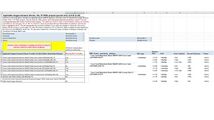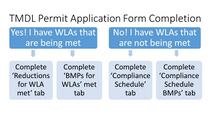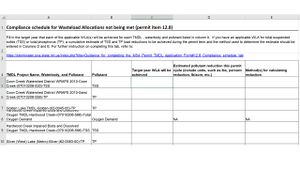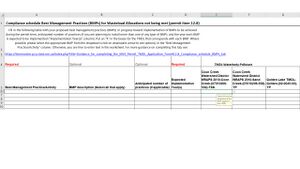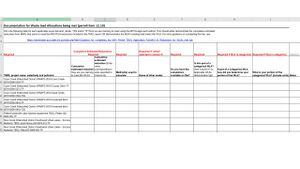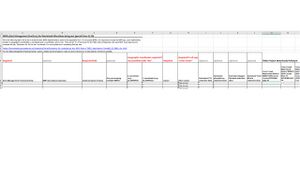
Guidance for completing the MS4 Permit TMDL Application Form
Contents
Phase I MS4 TMDL Application Form
Phase I MS4 TMDL Application Form Overview
This section of the page provides guidance for completing the Municipal Separate Storm Sewer System (MS4) Phase I Permit TMDL Application Form. Completing and submitting this form is a requirement for Phase I permittees who have United States Environmental Protection Agency (USEPA) approved Total Maximum Daily Load (TMDL) Wasteload Allocations (WLAs).
Attach your completed TMDL Application Form (and any accompanying supplemental information) to your submittal for reauthorization.
Description of the form
Each MS4 Permit TMDL Application Form is a custom created workbook for each Phase I permittee with United States Environmental Protection Agency (USEPA) approved Total Maximum Daily Load (TMDL) wasteload allocations (WLAs). The workbook consists of seven tabs. Two tabs are informational - for the permittee to reference while completing the other five tabs in this workbook.
Information tab
General instructions on how to complete the form, and reference links.
TMDL WLA list tab
This table is for reference only and shows ALL waste load allocations assigned to an MS4 and filtered for the specific permittee. Reference this list while completing the 'Applicable WLAs determination' tab. This list fulfills permit item Part IIB 1-5. This is a filterable list, and can be changed to show other permittees, projects, etc.
Applicable WLAs determination tab
The list in Column A contains any applicable WLAs (assigned to the permittee and USEPA approved) TMDL projects. They are listed by TMDL project name-waterbody-(waterbody id)-pollutant. The applicant needs to make a determination if they are meeting each WLA or not and type 'Yes' or 'No' in Column B. Once the determination is made, there is a macro that needs to run, and this will autopopulate the rest of the workbook.
Previously impaired waters that have been delisted, or if the permittee is listed as having no reductions required for a WLA on the TMDL WLA List would have a Yes determination on the 'Applicable WLAs determination' tab.
In order to complete that determination, the following may be needed:
- An inventory of structural stormwater BMPs and non-structural BMPs (e.g. establish ordinance, education and outreach, illicit discharge elimination, etc.) within the watershed boundary to the impaired water and that are being applied toward meeting the WLA(s). To determine watershed boundaries see the specific TMDL report or retrieve shapefiles from the MPCA.
- An estimate of annual cumulative pollutant load reductions (pounds or percent) for implemented BMPs.
- An estimate of pollutant loading rates (lb/ac/yr) to the impaired water.
Compliance schedule tab
This tab needs to be completed for each WLA that is not being met. Permittees will fill in the target year that each of the applicable WLA(s) will be achieved for each TMDL- waterbody- pollutant project listed in column A. A narrative discussing strategies for continued BMP implementation beyond the permit term is required for each WLA in column D.
Compliance schedule BMPs tab
This tab will be filled in with proposed best management practices (BMPs) or progress toward implementation of BMPs to be achieved during the permit term, and the year each BMP is expected to be implemented ("Implementation Year(s)" column). Put an "X" in the boxes for the TMDL that corresponds with each BMP. This tab is primarily for planned practices. Previously installed BMPs will be captured through future Annual Reporting.
- File:BMPs-quantifiable reductions and cross reference.xlsx - a spreadsheet that will assist you in determining what your BMP Activities should be classified as on the BMP tabs, as well as which BMPs can provide quantifiable reductions.
Narrative for WLAs met tab
This tab requires the permittee to submit required information for each applicable WLA they are claiming to meet. This should either demonstrate the cumulative estimated reductions from BMPs that serve to meet the MS4 WLA reductions included in the TMDL report OR demonstrates the MS4's existing load meets the WLA.
BMPs for WLAs met tab
This tab requires the permittee to submit required information for each applicable WLA they are claiming to meet with a list of all stormwater BMPs implemented to achieve the applicable WLA. For structural BMPs, it is required to include the BMP type and year implemented. Location in geographic coordinates (x coordinate and y coordinate) is optional.
- File:BMPs-quantifiable reductions and cross reference.xlsx - a spreadsheet that will assist you in determining what your BMP Activities should be classified as on the BMP tabs, as well as which BMPs can provide quantifiable reductions.
Phase II MS4 TMDL Application Form Overview
This section of the page provides guidance for completing the Phase II Municipal Separate Storm Sewer System (MS4) Permit TMDL Application Form. Completing and submitting this form is a requirement for Phase II permittees who have Total Maximum Daily Load (TMDL) Wasteload Allocations (WLAs) for total phosphorus (TP), total suspended solids (TSS), oxygen demand, or nitrate.
Attach your completed TMDL Application Form (and any accompanying supplemental information) to your submittal email for the MS4 Part 2 Application (PDF).
Description of the form
Each MS4 Permit TMDL Application Form is a custom created workbook for each permittee with United States Environmental Protection Agency (USEPA) approved Total Maximum Daily Load (TMDL) wasteload allocations (WLAs). The workbook consists of eight tabs. Three tabs are informational - for the permittee to reference in order to complete the MS4 Part 2 Permit Application, or to reference while completing the other five tabs in this workbook.
Information tab
General instructions on how to complete the form, and reference links.
Bacteria Chloride Temp tab
Informational tab- lists any applicable WLAs for bacteria, chloride or temperature TMDL projects (USEPA approved, more than a zero % reduction). Use the information in this tab to answer questions 141, 146 and 151 in the MS4 Part 2 Permit Application. If there is not a project listed for any certain pollutant, you would check the 'No' box for the corresponding question(s) in the MS4 Part 2 Permit Application.
Applicable WLAs determination tab
This tab includes two separate lists. The list in Column A contains any applicable WLAs (USEPA approved, more than a zero % reduction) for oxygen demand, nitrate, TSS, or TP TMDL projects. They are listed by TMDL project name-waterbody-(waterbody id)-pollutant. Column F lists the corresponding applicable numeric WLAs for those projects. If Columns A and F do not show any projects, you do not have any applicable WLAs, and you do not need to complete the TMDL Application. The list of permittees who have no applicable WLAs are located here. Otherwise, the applicant needs to make a determination if they are meeting each WLA or not and type 'Yes' or 'No' in Column B. Once the determination is made, there is a macro that needs to run, and this will autopopulate the rest of the workbook.
- Applicable WLAs Determination tab screenshots and Decision Tree. Click on an image for enlarged view.
In order to complete that determination, the following will be needed:
- An inventory of structural stormwater BMPs and non-structural BMPs (e.g. establish ordinance, education and outreach, illicit discharge elimination, etc.) within the watershed boundary to the impaired water and that are being applied toward meeting the WLA(s). To determine watershed boundaries see the specific TMDL report or retrieve shapefiles from the MPCA.
- An estimate of annual cumulative pollutant load reductions (pounds or percent) for implemented BMPs.
- An estimate of pollutant loading rates (lb/ac/yr) to the impaired water.
Recommended information to include in your narrative:
• What MS4 area did you use in your determination? (i.e. MS4 Boundary layer, NCLD developed land cover, entire jurisdictional area, etc.)
• Which WLA area did you use in your determination? (TMDL study area shapefile from Sharebase site, looked at map from TMDL report, some other delineation, etc.)
• If the units in the numeric WLA column on the ‘Applicable WLAs determination’ tab and the units used in the ‘Reductions for WLA met’ tabs do not correspond, please explain how you translated from one to the other.
Example narrative: The TMDL study area for X TMDL encompasses the entire municipality. Using the MPCA Simple Estimator tool, we entered land uses from the entire jurisdictional area to determine initial TSS loads before adding any BMPs. Then we added in current BMPs implemented since the baseline year to evaluate the overall wasteload. Our initial load was X pounds (before accounting for BMPs) and our final load was Y pounds (after adding BMPs).
Please consider including any other information that is not captured within the worksheet that will help explain your determination(s).
Compliance schedule tab
This tab needs to be completed for each WLA that is not being met. Permittees will fill in the target year that each of the applicable WLA(s) will be achieved for each TMDL- waterbody- pollutant project listed in column A. If there is an applicable WLA for total suspended solids (TSS) or total phosphorus (TP), a cumulative estimate of TSS and TP load reductions to be achieved during the permit term and the method used to determine the estimate should be entered in Columns D and E.
- Additional guidance on completing this tab Added April 1, 2021
Compliance schedule BMPs tab
This tab will be filled in with proposed best management practices (BMPs) or progress toward implementation of BMPs to be achieved during the permit term, anticipated number of practices (if the permittee is planning to install more than one of any type of BMP), and the year each BMP is expected to be implemented ("Implementation Year(s)" column). Put an "X" in the boxes for the TMDL that corresponds with each BMP. This tab is primarily for planned practices. Previously installed BMPs will be captured through future Annual Reporting.
- File:BMPs-quantifiable reductions and cross reference.xlsx - a spreadsheet that will assist you in determining what your BMP Activities should be classified as on the BMP tabs, as well as which BMPs can provide quantifiable reductions.
- New example of how to incorporate an activity for identifying when the WLA target year will be achieved
If your primary practices are going to be planning and analysis, you either need to provide enough detail on the compliance schedule tab itself by providing a comprehensive set of activities (including implementation strategy development), or provide additional detail in Q174 on page 32 of the MS4 Part 2 Application (PDF), or in a separate attachment. Additional details should include (but aren't limited to):
a. who will be completing any analyses (staff, consultants, etc),
b. if funding will be sought, who needs to approve it, and
c. in what order the planning activities and development of implementation strategies will be completed.
Reductions for WLAs met tab
This tab requires the permittee to submit required information for each applicable oxygen demand, nitrate, TSS and/or TP WLA they are claiming to meet. This substantiation needs to be completed using an MPCA-approved method. This should either demonstrate the cumulative estimated reductions from BMPs that serve to meet the MS4 WLA reductions included in the TMDL report OR demonstrates the MS4's existing load meets the WLA.
See Note above regarding additional information requested to explain determinations.
BMPs for WLAs met tab
This tab requires the permittee to submit required information for each applicable oxygen demand, nitrate, TSS and/or TP WLA they are claiming to meet with a list of all stormwater BMPs implemented to achieve the applicable WLA. For structural BMPs, it is required to include the BMP type, year implemented, location in geographic coordinates (x coordinate and y coordinate), and owner.
- File:BMPs-quantifiable reductions and cross reference.xlsx - a spreadsheet that will assist you in determining what your BMP Activities should be classified as on the BMP tabs, as well as which BMPs can provide quantifiable reductions.
Master list tab
This table is for reference only and shows ALL waste load allocations assigned to an MS4 and all flow zones, whether they need to be reported on in the TMDL application or not. This is a filterable list, and can be changed to show other permittees, projects, etc.
FAQ
Click here to see questions and answers from February 16 TMDL Webinar -Updated with links to draft phosphorus street sweeping calculator and revised loading rates spreadsheet.
1. For categorical WLAs – Are MS4 communities to report on BMPs in just their community, or do they also present data from other communities in the watershed to demonstrate compliance or progress towards the categorical WLA?
- Please see guidance at Guidance for categorical TMDLs. If the communities have agreed to work together, then data from other communities would be presented. If not, determine the permittee’s portion of the categorical WLA and present data towards that.
2. For categorical WLAs – Can private BMPs constructed in the watershed that have an overall pollutant reduction be included?
- Refer to the specific TMDL’s WLA methodology, in case certain areas have been excluded from the WLA; but generally, if it discharges to the conveyance system within the watershed, it should be creditable.
3. For the Compliance Schedule BMPs tab- should it only include BMPs that have yet to be implemented/installed or should it include already installed BMPs?
- It is allowable to include recently installed BMPs that have not yet fully reached their peak removal efficiency, or that will be improved upon over the permit cycle in your compliance schedule. (Enter them as implemented in 2020). Ultimately, the appropriate time to identify already implemented BMPs for WLAs not being met is when you complete the TMDL annual report form.
4. My Applicable WLAs Determination tab shows the percent reduction in Column I as "Not Available". Does that mean I don't have to report on that TMDL?
- No, that is incorrect. You will have to use the Numerical WLA found in Columns F & G to determine if you are meeting your WLA. Or check this spreadsheet to see if there is a loading rate that has been calculated for the WLA in question. If you don't see the TMDL you are looking for, contact Anna Bosch.
5. Is there any guidance on how to include street sweeping for TSS removal?
- There is limited guidance available here: TSS Credits for Street Sweeping.
Please submit questions to Anna Bosch at the MPCA.
Examples
- Case study for using P8 to meet TMDL permit requirements
- Case study for using WINSLAMM to meet TMDL permit requirements
- Case study for using the MIDS calculator to meet TMDL permit requirements
- Case studies for monitoring to meet TMDL permit requirements
Related pages and useful links
- GIS shapefiles for TMDL projects here
- Summary of TMDL requirements in stormwater permits
- Overview of models used to meet MS4 TMDL permit requirements
- Recommendations and guidance for utilizing P8 to meet TMDL permit requirements
- Recommendations and guidance for utilizing WINSLAMM to meet TMDL permit requirements
- Recommendations and guidance for utilizing the MIDS calculator to meet TMDL permit requirements
- MIDS calculator
- Recommendations and guidance for utilizing the MPCA Simple Estimator to meet TMDL permit requirements
- MPCA Simple Estimator
- Recommendations and guidance for utilizing monitoring to meet TMDL permit requirements
This page was last edited on 23 January 2023, at 14:48.
